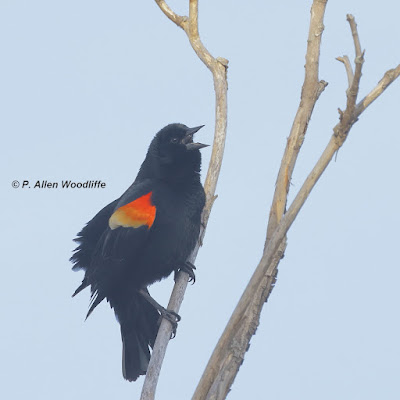Okay it isn't really orchid flowering season, nor is there much of anything else flowering for that matter. However the leafless season is one of the best times to find this one:
It is called Puttyroot (Aplectrum hyemale) and is an Endangered Species in Ontario and Canada. Rondeau is fortunate to have had several populations known from various parts of the park over the years, and I have been able to track down 7 different ones. Unfortunately at least two of those populations have disappeared, whether it is due to forest floor changes as a result of canopy cover alteration from the arrival of Emerald Ash Borer, which decimated the ash trees that were dominant in the canopy. Or maybe due to fluctuating water levels. Or something else entirely.At this time of year, they are not in flower, but their overwintering leaves are distinctive and if one is concentrating sufficiently on the leaf litter, they can stand out nicely. Each leaf represents an individual plant, but very few will actually flower in a given year. In the main population, which I have been following for more than 3 decades, I have sometimes seen up to about 75 leaves, but never seen any more than about 20 with a flowering stem and in flower and that was in a good year. More typically I only see a dozen or so in flower at the most.
While out looking around a few weeks ago, I cane across a new-to-me population with 7 leaves, a single leaf of this new population is shown next. Given the habitat that this species occurs in, I expect there are more populations as yet unseen. There are hundreds and hundreds of what appears to be suitable habitat. The leaves are starting to dry and they will almost totally disappear before long.It will be interesting to see how many flowering stems are found this year.There are other things that are actually in flower. This first one is called Snowdrops. It flowers early, and is not native. It often occurs in fairly abundant little patches. This patch occurred next to a cottage in the park.
One that is native, but not often seen, is called Skunk Cabbage. The green and purple stems emerge from a fairly wet area, sometimes where standing water is present at least in early spring. It doesn't occur at Rondeau. I have been keeping an eye on this small population at Clear Creek Forest Prov Park.A closer look inside one of the purple leaves, known as a spathe, may show the little cluster of flowers, as seen here.Over the next few weeks, I am looking forward to finding a lot of other spring wildflowers! In the meantime, there is hopefully an increasing number and variety of birds to look for and try and photograph. American Robins are becoming quite numerous, with sometimes several dozen seen on even a short outing. On one occasion on a cold day and driving through a small town, I drove by what looked to be a type of crabapple tree. Underneath were at least 30 robins groping around in the lawn, looking for crabapple residue.
American Pelicans have appeared in southwestern Ontario in recent days. Of course a birder and photographer always hopes to get views such as this next one, which I photographed flying over Rondeau Bay near Erieau last year. Opportunities such as this do not occur very often.........as this next photo illustrates. This photo was taken from the Mitchell's Bay South Nature Trail, where as many as a dozen pelicans were resting on the sheltered edge of a large stand of cattails. In viewing them through binoculars, it was difficult to know for sure that they were in fact pelicans, or some of the many large swans that were also in the area. I know of at least a few birders who ventured out to try and see these birds, but were not successful. However a high powered 'scope confirmed them as pelicans, as every few minutes one would get up, stretch its neck and it large orange bill would be obvious. At other times one would stretch its wings, and the black wing tips and outer primaries would be distinctive. The photo below is the best I could do. Even with my top quality lens, this photo was taken, and subsequently cropped to be at slightly more than 100X.Sandhill Cranes continue to be around, although they are starting to pair up and instead of large groups, are often in groups of four or fewer.
Of course Red-winged Blackbirds have arrived in large numbers especially in wetland areas, where they are seen and heard giving their choke-er-ee calls attempting to lure in a female as they arrive.
Not to be left out of the wildlife scene of late, are turtles especially on some of the warmer days. Blanding's Turtles are an Endangered Species. I usually see a few, such as this next one, along the Marsh Trail near Erieau.On the other hand, Midland Painted Turtles are fairly abundant. On this day I counted at least 40 all sunning on a log or some similar spot.There is always lots to see!
If you would like to subscribe, or unsubscribe, to Nature Nuggets, send an email to: prairietramper@gmail.com




























Beautiful series of photos.
ReplyDeleteThank-you!
Delete